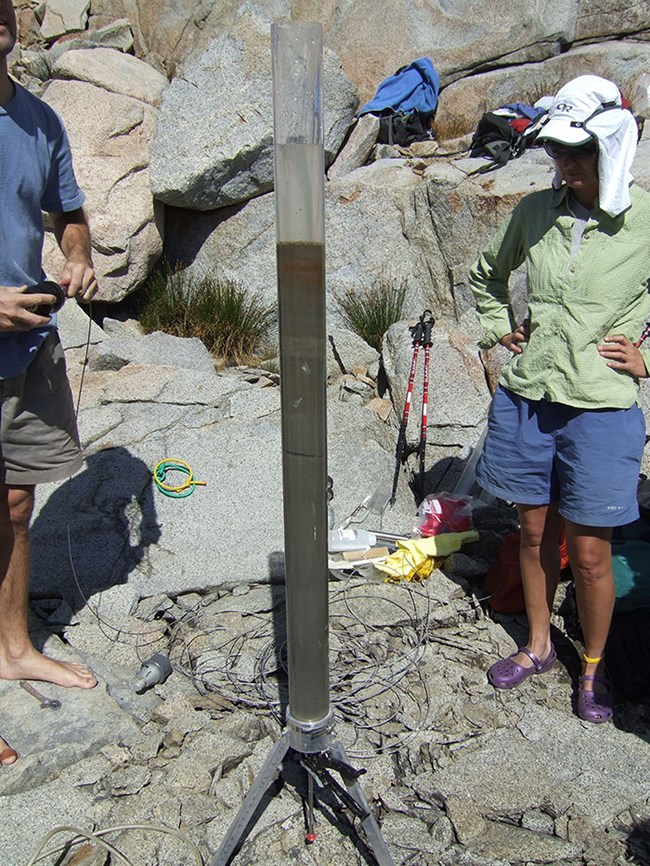Last updated: November 16, 2023
Article
Environmental Policy Making a Difference: The Clean Air Act and Mountain Lakes

Jeff Empke for NPS Air Resources Division
As early as the 1920s, Sierra Nevada lakes, despite their remote wilderness locations, showed increased acidification associated with industrialization. By the late 1970s, acidification began declining. A clear example of environmental policy making a difference, water quality in lakes improved in response to implementation of the Clean Air Act initiated in 1970 and further amended in subsequent years.
Getting the Drift – Linking Air and Water
How do air pollutants end up in remote lakes? As shown in Figure 1, nutrients and acids produced by industry, agriculture, and vehicles drift into the mountains on air currents and are deposited via rain, snow, and dry deposits (such as particles of dust). These pollutants travel from California’s Central Valley, the San Francisco Bay Area, and as far away as Asia. Pollutants such as ammonium, nitrate, and sulfate acidify mountain lakes, decreasing their acid-neutralizing capacity, and altering the biotic communities of plants and animals in these lakes.

How do we know lakes have changed?
Aspects of a lake’s history can be revealed by examining biological and chemical measures that are preserved in lake sediment layers through time. Scientists have reconstructed historic acidification trends using a Sierra Nevada lake sediment core (Figure 2, Sickman et al. 2013). They found by examing changes in algae presence over time, the lake was changing as early as the 1920s with acidification increasing through 1970. However, from 1970 through the mid-2000s, the trend reversed and the lake became less acidified - an apparent response to enactment of the Clean Air Act and its Amendments.
Were the observed changes in acidity definitely linked to air pollutants being deposited in the Sierra Nevada? A second study examined multiple lines of evidence to understand the effect of human actions on Sierra Nevada lakes throughout the 20th century.
By-products of industrial fossil fuel combustion, known as spheroidal carbonaceous particles (or SCPs), were quantified in lake cores (See Figure 3 for SCP example). SCPs are transported and deposited in mountain lakes, where they are preserved in the sediments. As there are no natural sources of SCPs, they are an excellent indicator of human-caused atmospheric deposition.
SCP patterns were strongly correlated with the acidification trends, as were 20th century sulfur emissions. These correlations between acidification, air pollution, and deposition suggest that acid deposition caused the early 20th century acidification (Heard et al. 2014).
How did these lakes change?
How did SCPs change in Moat and Pear Lakes?
Patterns were similar between Moat and Pear lakes: As shown in Figure 3, SCP concentrations gradually increased in the mid to late 19th century and then rose faster in the early part of the 20th century. SCPs in Pear and Moat lakes began to decline from approximately 1970 to 1985 in response to declining pollution from industrial fossil fuel burning.
How are SCPs and ANC related?
A reconstruction of acid-neutralizing capacity (ANC) is shown for Moat Lake in Figure 3. Statistical analyses demonstrate negative correlations between ANC and SCPs. This relationship is visibly evident in the Moat Lake graphic showing acid neutralizing capacity being low when SCPs are high. ANC begins to recover (i.e., increase) by around 1980 as SCPs decline following enactment of the Clean Air Act. This change was attributed to the reduction in pollution indicated by declining SCPs.


NPS / G. Puig-Santana
Lake Pollution Remains a Problem
While the recovery of Moat Lake ANC is a positive outcome that further documents the already noted successes of the Clean Air Act and Amendments, Sierra Nevada lakes need continued monitoring and protection. Research being conducted at a larger spatial scale suggests that lakes in this region are still affected by acid deposition. Current emissions reductions are not sufficient to allow for full recovery of more sensitive lakes.
Continued long-term monitoring of Sierra Nevada lakes provides data for evaluating change, informing management and research, and assessing the effectiveness of environmental policies.
More Information
Contact Sierra Nevada Network Physical Scientist Andi Heard for more information, or visit our Lakes Monitoring web page.
Download Resource Brief here.
This article was based on the following publication:
Heard, A. M., J. O. Sickman, N. L. Rose, D. M. Bennett, D. M. Lucero, J. M. Melack, and J. H. Curtis. 2014. 20th century atmospheric deposition and acidification trends in lakes of the Sierra Nevada, California, USA. Environmental Science & Technology 2014, 48, 10054-10061.
Additional citations:
Sickman, J. O., D. Bennett, D. M. Lucero, T. J. Whitmore, and W. F. Kenney. 2013. Diatom-inference models for acid-neutralizing capacity and nitrate based on a 41-lake calibration dataset from the Sierra Nevada, California, USA. Journal of Paleolimnology 50: 159-174.
This was a collaborative project involving: University of California, Riverside, University of California, Santa Barbara, University of Florida, University College London, and the National Park Service.
